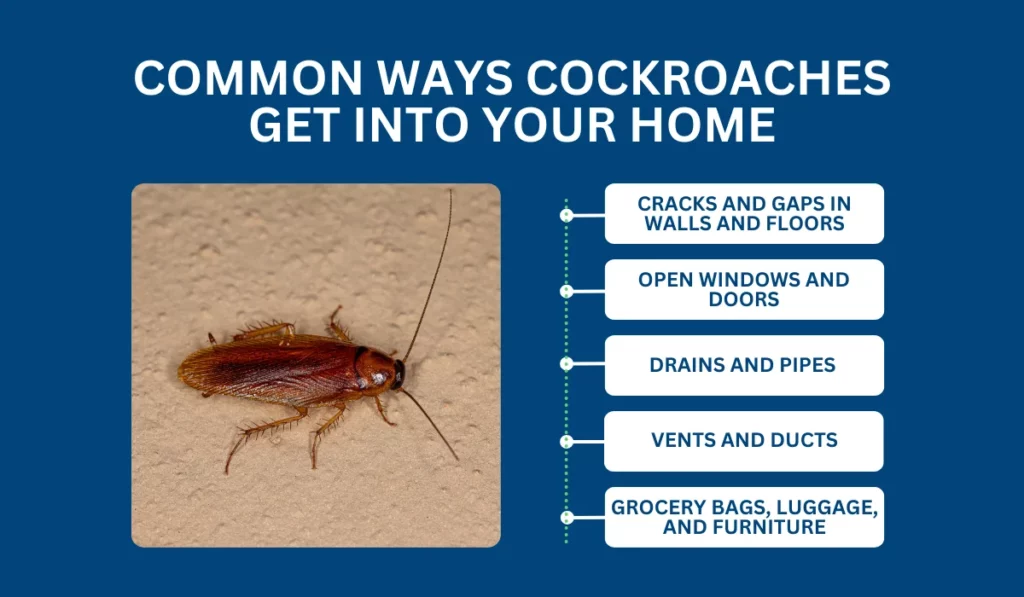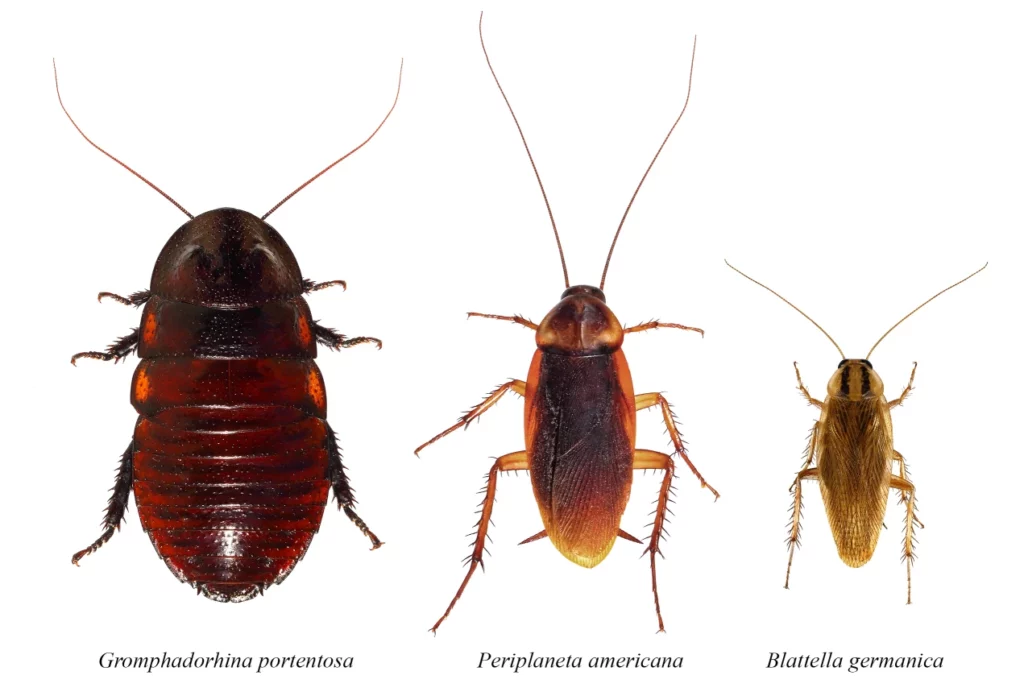Florida’s subtropical climate offering warm temperatures, year-round humidity, and only mild drops in winter allows cockroaches to thrive indoors without seasonal slowdowns. In Pensacola, a key Gulf Coast city in Florida’s Panhandle, these resilient pests can squeeze into single-family homes, short-term rentals, or commercial spaces whenever leftover food scraps, moist corners, or small entry cracks lure them. Once established, roaches frequently lurk behind appliances, in wall voids, or beneath baseboards. This page uncovers why cockroaches persist in Florida, how to detect a possible infestation, and why contacting a professional cockroach exterminator is essential for achieving a roach-free, hygienic property.
Whether you own a residence in Pensacola or manage short-term units also serving Cantonment or Molino, recognizing roach activity early and using specialized, multi-step solutions protects occupants from health hazards, roach-driven anxiety, and unending do-it-yourself efforts that usually ignore deeper egg casings or concealed roach nests within walls.
Why Cockroaches Flourish in Florida
Mild Winter Temperatures
In colder regions, subfreezing weather significantly suppresses roach populations for months. Florida’s gentle cold season rarely dips below freezing, meaning cockroaches can feed, lay eggs, and mature indoors all year. Climate-controlled interiors (about 65–85°F) further eliminate seasonal constraints, ensuring continuous reproduction if occupant or manager vigilance is lacking.
Plentiful Food & Moisture
Roaches eat any organic scraps, unsealed pantry goods, kitchen leftovers, or pet kibble left out. In busy Pensacola households or lodging settings, occupant routines may unintentionally supply roaches with leftover crumbs if daily cleanup or waste disposal is overlooked. Even mild water leaks under sinks or A/C units provide enough moisture to sustain roaches in Florida’s humidity.
Rapid Breeding Cycles
A single female roach carries multiple egg casings (oothecae), each containing multiple embryos. In Florida’s year-round warmth, eggs hatch within weeks, allowing roach nymphs to mature swiftly if occupant or professional checks don’t identify them. Ignoring early droppings or sightings often spawns large-scale infestations hidden behind walls or in low-traffic zones.
Multiple Cockroach Species
Florida hosts various roach types:
- German Cockroach: Small, rapidly multiplying indoors, commonly seen in kitchens/bathrooms.
- American (Palmetto) Cockroach: Larger, often living outdoors but entering properties for food or cooler air.
- Smoky Brown Cockroach: Prefers damp mulch or shrubbery, occasionally slipping inside.
- Brown-Banded Cockroach: Favoring drier, elevated areas top cabinets or electronics.
All can thrive indoors if occupant synergy or professional control doesn’t break their breeding cycles, especially in Florida’s mild winter that rarely hinders roach activity.

Telltale Signs of a Cockroach Infestation
- Live Roach Sightings
- Roaches typically hide during daylight hours, emerging at night. Spotting them in daylight suggests a sizable nest forcing some to roam.
- Kitchens and bathrooms often reveal roaches scurrying when lights turn on.
- Roaches typically hide during daylight hours, emerging at night. Spotting them in daylight suggests a sizable nest forcing some to roam.
- Droppings & Smear Marks
- German roach droppings look like fine black pepper, whereas American roach feces are larger and cylindrical.
- Brownish smears may appear along damp edges or baseboards where roaches travel frequently.
- German roach droppings look like fine black pepper, whereas American roach feces are larger and cylindrical.
- Egg Casings (Oothecae)
- Capsule-like containers carrying multiple embryos, stashed behind cabinets, under sinks, or near baseboards.
- Proof of active roach breeding cycles within the property.
- Capsule-like containers carrying multiple embryos, stashed behind cabinets, under sinks, or near baseboards.
- Musty, Oily Odors
- Dense roach populations release a strong, foul smell from droppings or bodily secretions.
- More pungent odors typically indicate larger, well-established colonies.
- Dense roach populations release a strong, foul smell from droppings or bodily secretions.
- Chewed Packaging
- Roaches gnaw cardboard or thin plastic to reach stored foods.
- Torn or ragged edges on boxed items or bags confirm roach feeding.
- Roaches gnaw cardboard or thin plastic to reach stored foods.
- Occupant or Guest Complaints
- In multi-unit or short-stay rentals, occupant sightings or roach scuttling upon entering a room can signal widespread infiltration.
- Prompt occupant or manager intervention prevents roaches from migrating between rooms or floors.
- In multi-unit or short-stay rentals, occupant sightings or roach scuttling upon entering a room can signal widespread infiltration.
Why Overlooking Roaches Is Hazardous
Disease Transmission & Contamination
Roaches traverse unsanitary areas like dumpsters or drains harboring pathogens (salmonella, E. coli) on their bodies. Tracking these microbes onto countertops, pantries, or utensils imperils occupant health.
Allergen Triggers
Cockroach droppings, shed skins, and saliva hold allergens that exacerbate asthma or respiratory troubles in some occupants. Overlooking an infestation fosters bigger roach loads and higher allergen levels.
Accelerated Colony Growth
Females produce multiple egg cases, each quickly hatching. Florida’s year-round mild winter fosters non-stop roach breeding. Over time, a small infiltration becomes a multi-room or multi-floor issue if occupant or professional checks lag.
Occupant Stress & Brand Image
Large roach sightings undercut occupant trust in property cleanliness especially in lodging near Cantonment or Molino. Short-term rentals or hotels see occupant backlash or harmful online reviews if roaches endure unaddressed.
Escalating Treatment Expense
Minor roach outbreaks caught early might only require moderate occupant disruption like properly placed baits or partial spraying. Delaying until roaches saturate multiple floors or behind walls demands repeated treatments or occupant relocation, raising occupant frustration and final costs.
Why a Professional Cockroach Exterminator Is Essential
Thorough Property Reviews
A cockroach exterminator inspects moist areas, kitchens, or bathroom corners for droppings, egg cases, or smear marks. Identifying roach species German, American, etc. guides whether localized interior coverage or perimeter emphasis is crucial for occupant needs.
Strategic Baiting & Sprays
Professionals position gel baits or bait stations along roach “runways” (wall edges, under sinks), ensuring they ingest poison that eventually spreads to hidden nests. Residual sprays near cracks/baseboards kill roaches crossing those surfaces. This synergy surpasses occupant attempts reliant on random foggers or aerosol sprays missing deeper roach strongholds.
Insect Growth Regulators (IGRs)
IGRs hinder nymphs from reaching adulthood. When applied with adulticidal baits or sprays, they eradicate roach life cycles. Occupant do-it-yourself methods often skip nymph stages, letting roach populations rebound once adults die off.
Minimized Chemical Exposure
Occupant over-spraying can saturate living zones, risking occupant or pet safety. Exterminators use regulated insecticidal dust or sprays exactly where roaches hide
behind cabinets, in wall voids paired with occupant synergy (removing food scraps). Gel baits remain hidden, lethal to roaches yet safer for occupants.
Follow-Up & Preventative Steps
Roach egg casings can hatch weeks after occupant sightings vanish. Occupant synergy or second exterminator visits ensure newly hatched nymphs also confront lethal conditions. Occupants gain housekeeping tips storing foods properly, sealing leaks so roaches cannot easily return.

Common Cockroach Treatment Methods
- Inspection & Species Identification
- Technicians examine corners, under appliances, or in damp areas for droppings, egg cases, or smear marks.
- Knowing roach type (German, American, etc.) clarifies partial or perimeter coverage best suiting occupant or staff needs.
- Technicians examine corners, under appliances, or in damp areas for droppings, egg cases, or smear marks.
- Gel Baits & Bait Stations
- Placed in corners, under sinks, or near cabinets spots roaches frequent for slow-acting poison ingestion.
- Roaches carry this poison to nests, poisoning more members over time.
- Placed in corners, under sinks, or near cabinets spots roaches frequent for slow-acting poison ingestion.
- Residual Sprays & Dust
- Sprays or crack-and-crevice dust in baseboard edges or wall voids kill roaches crossing treated surfaces.
- Combining dust for hidden nest pockets plus occupant synergy ensures thorough coverage.
- Sprays or crack-and-crevice dust in baseboard edges or wall voids kill roaches crossing treated surfaces.
- Insect Growth Regulators (IGRs)
- Interrupt roach nymph development, stopping them from producing new eggs.
- Often merged with adulticidal baits or sprays, targeting each roach life cycle stage.
- Interrupt roach nymph development, stopping them from producing new eggs.
- Exclusion & Repairs
- Occupants or professionals fix foundation cracks, door sweeps, or fill utility line gaps roaches exploit.
- Eliminating dampness (repairing leaks) denies roaches vital moisture, essential in Florida’s humid environment.
- Occupants or professionals fix foundation cracks, door sweeps, or fill utility line gaps roaches exploit.
- Sanitation & Clutter Reduction
- Occupants discard leftover food daily, store items in sealed containers, or wipe counters thoroughly.
- Minimizing cardboard boxes or random paper stashes reduces roach hideouts behind or under items.
- Occupants discard leftover food daily, store items in sealed containers, or wipe counters thoroughly.
- Maintenance & Follow-Up
- Weeks post-treatment, occupant sightings or sticky traps confirm leftover roaches or newly hatched nymphs.
- Additional occupant housekeeping, re-check visits, or targeted baits finalize occupant comfort that roaches are gone.
- Weeks post-treatment, occupant sightings or sticky traps confirm leftover roaches or newly hatched nymphs.
- Inspection & Species Identification

Serving Pensacola, Cantonment, Molino
Although cockroaches adapt statewide to Florida’s near-constant mild winter climate, this page targets roach solutions for Pensacola, plus the neighboring communities of Cantonment and Molino, where occupant synergy plus specialized treatments remain vital for total roach eradication or prevention. Florida’s gentle winter seldom hinders roach reproduction, necessitating occupant readiness and professional extermination for complete coverage.
Why Choose Us
Florida-Calibrated Methods
We merge recognized cockroach management gel baits, insect growth regulators, crack-and-crevice dusting suited to Florida’s environment. By coupling occupant housekeeping (securing leftover food, resolving dampness) with advanced exterminator coverage, adult roaches and upcoming nymphs are thwarted, outperforming occupant attempts that skip deeper egg casings or hidden roach highways.
Exhaustive Property Examinations
Before distributing bait or dust, technicians meticulously check behind appliances, in damp corners, or along baseboards for droppings, smear marks, or egg casings. Confirming roach species German vs. American etc. clarifies if localized interior or perimeter coverage is appropriate for occupant needs.
Safe, Focused Chemical Use
We apply insecticides and dust exclusively where roaches dwell baseboards, behind cabinets avoiding occupant floors or counters. Gel baits stay concealed yet lethal to roaches, limiting occupant or pet chemical exposure.
Emphasis on Prevention & Sanitation
Killing current roaches is half the solution. Occupants or professionals then seal foundational cracks, fix leaks, or store leftover food in sealed containers, so new roaches face a less appealing environment. This occupant-professional synergy cements roach freedom despite Florida’s mild winter advantage for year-round breeding.
Follow-Up & Accountability
Roach egg casings can hatch weeks after occupant sightings dwindle. Many exterminators remain on call or schedule occupant re-check visits if droppings resurface, re-adjusting baits or occupant housekeeping for occupant certainty that roaches no longer lurk.
Next Steps
Seeing roaches dash when lights switch on, noticing black pepper-like droppings under sinks, or egg casings behind cupboards? Contact us to learn more or schedule your service. Our cockroach treatments in Pensacola and neighboring Cantonment, Molino combine methodical property checks, properly placed baits or dust, occupant-friendly sealing and sanitation steps, plus vital follow-ups comprehensively eradicating infestations while discouraging fresh infiltrations.
Act swiftly to protect occupant or guest health from roach-borne bacteria, keep your environment cleaner, and preserve occupant trust if you operate short-term rentals or multi-unit housing. Rely on our Florida-based cockroach exterminator expertise to detect, eliminate, and deter roaches effectively, negating their mild winter breeding cycles along Florida’s Gulf Coast so occupant comfort and property cleanliness endure year-round.
